List of translated texts

|
Practice text passages intended for recitation are given in Tibetan, phonetic transcription, and English translation. Other texts or passages are in Tibetan and English only. No need to trek to India to fetch texts on elephant back these days, just click on a title to view them! |

|
Accomplishing the Aim of Meditation
One of thirteen early Mind Series texts said to have been translated into Tibetan by Vimalamitra, Nyak Jnanakumara, and Yudra Nyingpo. This text was thought to have been lost. I located it in the Rig 'dzin tshe dbang nor bu manuscript of the rNying ma'i rgyud 'bum in the Bodleian library, Oxford. For more information, please see my article from the October 2009 issue of the Revue d'Etudes Tibetaines. I have included the Tibetan text in a separate file. (Please note: since writing the article, I have obtained a commentary on this text, and have slightly amended my translation accordingly) |

|
The Lamp of the Three Realms
This text is very probably the same as the "Wish-fulfilling Jewel", another "lost" text from the thirteen early Mind Series works that I am studying for my PhD. For more information, please see my article from the October 2009 issue of the Revue d'Etudes Tibetaines. Here is the Tibetan. |

|
The Cuckoo of Awareness
"The Cuckoo of Awareness" (Rig pa'i Khu Byug), together with a commentary, is found among the Dunhuang manuscripts at the British Library. The root text is also the first in a list of five early Dzogchen translations attributed to Vairocana, a contemporary of Padmasambhava (eighth century C.E.). Numerous translations of the root text are already available, but I have not seen any others of the Dunhuang commentary apart from that in Samten Karmay's "The Great Perfection", (Brill, 1988). At least the first section of the commentary was possibly written by Vairocana himself. A modern, and very helpful commentary on the text is included in Namkhai Norbu Rinpoche's "Dzogchen, the self-perfected state" (Snowlion, 1996). The Tibetan as I have given it faithfully follows the original manuscript (at the IDP), including its occasional non-standard spellings. This translation is provisional, and I will likely revise it in the future. |
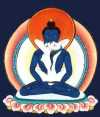
|
The Small Hidden Grain
The Small Hidden Grain (sBas pa'i rGum Chung) by Buddhagupta is one of the very early Dzogchen texts among the Dunhuang documents at the British Library. The main theme of the text is the Enlightened Mind. It is composed of three elements: an introduction, the main text (written in red ink in the Tibetan) and interlinear notes. As these notes appear to preserve the essential points of an oral teaching on the text, they are of especial interest. I have therefore tried to show the relationship of the notes with the text as clearly as possible, by following the layout of the original in the Tibetan, and in the footnotes to my English translation. |
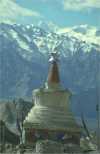
|
Advice to Kunzang Chögyal
This succinct and down-to-earth piece of advice was written by Dza Patrul Rinpoche (1808-1887) for a student and friend who had asked him how he should practise. It sums up what real Dharma practice means - training our own minds, so that we can experience its results for ourselves, not to impress others. It also essentialises the View, Meditation, and Action of Dzogchen in a typically pithy, memorable way. My thanks to Ranyak Patrul Rinpoche for his own helpful advice to me when translating this text. |

|
Nine Considerations and Criteria for Benefiting Beings
Practical advice on how a Bodhisattva should decide on the best course of action, in a succinct and memorable piece written by the famous Dzogchen Master Dza Patrul Rinpoche, never before translated into English (to my knowledge). I have added some explanatory notes on technical terms at the end. As this is not a practice text, and is written in prose form, I have decided to include the Tibetan separately from the English translation. |

|
Chöd
This Chöd Practice, entitled "The Loud Laugh of the Dakini", is from the Longchen Nyingthig cycle of terma teachings revealed by the master Jigme Lingpa (1729-1798). Chöd means "cutting", and is a powerful, dramatic practice of cutting through ego-attachment and delusion by visualising offering up one's body to malevolent spirits and karmic creditors. Machig Labdrön, who lived in the eleventh century AD, is probably Tibet's most famous female practitioner of Chöd. I relied on an earlier translation published by the Dzogchen Shri Singha Five Sciences Buddhist University in producing this lightly revised English version. |
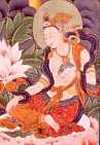
|
A Yearning Song of Faith
This is a reverential petition (gsol 'debs) to the Dakini Yeshe Tsogyal, pleading for aid in facing dark times. It was written (I believe) by Jigme Trinle Öser, the first Dodrupchen Rinpoche, a close disciple of Jigme Lingpa. It often accompanies the practice of Yumka Dechen Gyalmo, the Longchen Nyingthig Dakini sadhana, in which Yeshe Tsogyal is the principal meditational "deity". As far as I am currently aware, this has not been previously translated. |
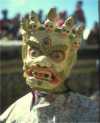
|
Bardo Prayers
These prayers were written down by the fourteenth century tertön Karma Lingpa, and are traditionally recited as guidance to the dead and dying. The "Prayer Requesting Assistance from the Buddhas and Bodhisattvas," requests all enlightened beings to comfort those who are dying or who are suffering in the intermediate states after death (Bardos). "Root verses of the Bardo Tödral (Liberation on Hearing in the Bardo)" encapsulates the essential instructions on each phase of the Bardos. The "Prayer that protects from fear in the Bardos" appeals for the Buddhas' and bodhisattvas' compassionate refuge from fear. The "Prayer for Deliverance from the Bardo's Narrow Passage" outlines the experiences of the Bardo of Reality or Dharmata, in order to help the dead person to recognize the true nature of the visions that arise there. I referred to earlier French and English versions in my re-working of these texts, and also received useful clarifications from Ranyak Patrul Rinpoche. |
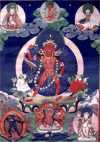
|
The Queen of Great Bliss
(yum mkha' bde chen rgyal mo) [NOTE: Traditionally, empowerment, reading transmission, and explanatory teaching from a qualified teacher are necessary in order for such a sadhana to be fully understood and practised.] This is the Dakini practice from the famous Longchen Nyingthig Cycle, written down by Jigme Lingpa. Although as a sadhana it is a Tantric practice, it is imbued throughout with the Dzogchen perspective. I referred to several earlier English versions, including that produced by the Dzogchen Shri Singha University, when re-translating this text. This is a brief version, omitting many prayers that customarily accompany the practice when it is performed in groups. |

|
Two prayers by Dza Patrul Rinpoche
Two short prayers written by the great Dzogchen master Dza Patrul Rinpoche. Unfortunately I do not know the exact circumstances in which they were originally written. They ask the Protectors of the Teachings for help in quelling discord and dissimulation in Dharma circles and in everyday life - a request as relevant as ever. |

|
The Dakini Prayer which spontaneously accomplishes the two goals
Written by Jigme Trinle Oser, the first Dodrupchen Rinpoche, a close disciple of Jigme Lingpa. This prayer invokes the dakinis and the masters of the Longchen Nyingthig lineage, to grant the practitioner supreme and ordinary accomplishments ("supreme accomplishment" being a synonym for enlightenment). |
You will need a PDF reader to view and print these files. A good one can be downloaded free from Foxit at http://www.foxitsoftware.com/ (hold down the shift key and click to open this link in a new window).
Linking directly to a file is not allowed - please link either to this page or to the home page.
